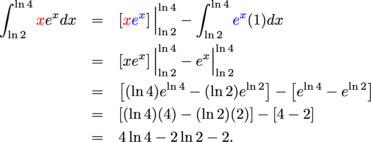As with integration by substitution, there are two distinct ways to integrate definite integrals using integration by parts. As with integration by substitution, we have to be careful not to mix the ways up!
Way 1: First integrate the indefinite integral
This method is analogous to the Way 1 we introduced for integration by substitution. When asked to evaluate a definite integral,
- use integration by parts to find an antiderivative of the integrand and then
- use the FTC to evaluate the integral.
Way 2: Keep the limits of integration after applying the formula
The second way to use integration by parts on definite integrals is to keep the limits of integration all the way through. When we apply the magic formula for integration by parts, it will look like this:

We're not just keeping the limits of integration on the integral; we also need to evaluate uv from a to b:

This is the step that's easiest to forget, so we'll probably remind you several more times.











































